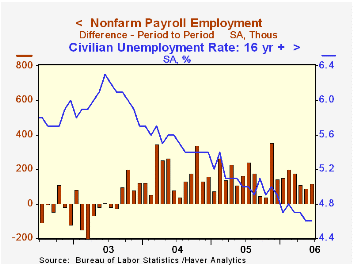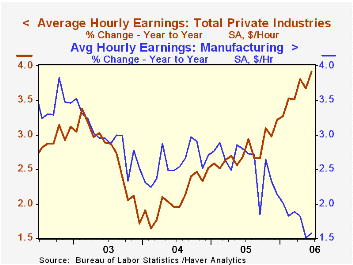 Global| Jul 07 2006
Global| Jul 07 2006Growth in U.S. Payrolls Moderate, Wages Jump
by:Tom Moeller
|in:Economy in Brief
Summary
A 121,000 gain in June nonfarm payrolls fell short of Consensus expectations for a 155,000 increase. Disappointment should be mitigated, however, by details within the jobs report that indicate continuing, moderate expansion of the [...]

A 121,000 gain in June nonfarm payrolls fell short of Consensus expectations for a 155,000 increase. Disappointment should be mitigated, however, by details within the jobs report that indicate continuing, moderate expansion of the U.S. labor market.
Revisions raised the gain in May payrolls to 92,000 and a 15,000 worker June gain factory sector payrolls pulled the y/y growth positive (barely) for the first time since 2000.
From the household survey, the unemployment rate remained low at an expected 4.6% due to a whopping 387,000 (1.8% y/y) gain in employment while the labor force rose 330,000 (1.4% y/y). The labor force participation rate rose to 66.2%, its highest level in three years, though the rate for males over 20 dropped to a low 75.7%. That decline was offset by a rise in the participation rate for females over 20 to 60.6%.
Lengthening of the workweek to an average 33.9 hours raised aggregate weekly hours worked in private industry by 0.4%. That was enough to raise the 2Q level 2.3% (AR) versus a 1Q increase of 3.0%. Both figures are improved versus 2.2% average growth during the second half of last year.
Average hourly earnings jumped 0.5% versus an expected 0.3% increase and an unrevised 0.1% May up tick. The 3.9% y/y gain is the strongest since 2001. Private service-producing wages rose 0.4% (4.3% y/y) while factory sector earnings rose 0.2% (1.6% y/y).
The breadth of one month gain in private payrolls fell to 55.4% in June versus a high 61% in January and 61.7% last November. For the factory sector, a 54.8% one month breadth of gain was improved from 42.7% during all of last year.
Factory sector payrolls advanced for the second month in the last three due to growth in the electrical equipment & appliance (2.6% y/y) industry as well as in computer & electronic products (0.7% y/y), machinery (1.8% y/y) and chemical (1.3% y/y) sectors. Growth in most other nondurable goods industries continued negative.
Private service-producing jobs rose a modest 75,000 (1.5% y/y) last month, about the same as in May. The per month average gain of 69,000 during 2Q was the weakest since 3Q 2004. Retail trade sector jobs fell 6,600 (-0.2% y/y), the third decline in the last four months. Financial sector jobs rose 3,000 (2.5% y/y) and professional & business services employment rose 25,000 (2.6% y/y). Temporary help services jobs fell by 7,900 (+3.2% y/y). It was the fourth m/m decline this year though May was revised to show an increase. Jobs in education & health services rose 26,000 (2.2% y/y).
Construction employment reversed all of an upwardly revised 4,000 May increase (3.1% y/y).
Is the United States Bankrupt? from the Federal Reserve Bank of St. Louis is available here.
| Employment | June | May | Y/Y | 2005 | 2004 | 2003 |
|---|---|---|---|---|---|---|
| Payroll Employment | 121,000 | 92,000 | 1.4% | 1.5% | 1.1% | -0.3% |
| Manufacturing | 15,000 | -8,000 | 0.1% | -0.6% | -1.3% | -4.9% |
| Average Weekly Hours | 33.9 | 33.8 | 33.7 (June '05) | 33.8 | 33.7 | 33.7 |
| Average Hourly Earnings | 0.5% | 0.1% | 3.9% | 2.8% | 2.1% | 2.7% |
| Unemployment Rate | 4.6% | 4.6% | 5.0% (June '05) | 5.1% | 5.5% | 6.0% |
Tom Moeller
AuthorMore in Author Profile »Prior to joining Haver Analytics in 2000, Mr. Moeller worked as the Economist at Chancellor Capital Management from 1985 to 1999. There, he developed comprehensive economic forecasts and interpreted economic data for equity and fixed income portfolio managers. Also at Chancellor, Mr. Moeller worked as an equity analyst and was responsible for researching and rating companies in the economically sensitive automobile and housing industries for investment in Chancellor’s equity portfolio. Prior to joining Chancellor, Mr. Moeller was an Economist at Citibank from 1979 to 1984. He also analyzed pricing behavior in the metals industry for the Council on Wage and Price Stability in Washington, D.C. In 1999, Mr. Moeller received the award for most accurate forecast from the Forecasters' Club of New York. From 1990 to 1992 he was President of the New York Association for Business Economists. Mr. Moeller earned an M.B.A. in Finance from Fordham University, where he graduated in 1987. He holds a Bachelor of Arts in Economics from George Washington University.






